ultrabooks
Latest

Dell XPS 15 review (2020): The ideal 15-inch laptop for creatives
Dell's XPS 15 is the premium 15-inch notebook we've been waiting for. It's faster, has a bigger screen and finally has a refreshed design.

LG's new touchscreens will make your next laptop thinner and lighter
LG's display subsidiary is promising drastically thinner, lighter touchscreens that will be ready for notebooks later this year. With full HD (1080p) resolution, the Advanced In-Cell Touch (AIT) screens substitute a touch panel layer for a touch sensor built into the LCD itself -- that's what makes it thin. It's the same tech found in smartphones like LG's own G4, but this is the first time it's been sized up to laptops. Thickness savings will be around 25 percent, while weight reductions could be as much as 35 percent compared to typical laptop touchscreen. That reduction in layers also translates to less light reflection, which LG Display reckons will make the new screens brighter and clearer. The company plans to roll out multiple sizes, with stylus-compatible models also on the way. If these screens are going to shave the profile of your next Ultrabook even further, there might be no other choice but to go with a few of those oh-so-slender USB-C ports.

This is Toshiba's answer to the Surface Pro 3
Until now, if you wanted a tablet powerful enough to double as a laptop, there was really only one acceptable option: the Surface Pro 3. Sure, there were other such devices out there, but the SP3 was uniquely thin and light -- kind of a crucial detail for a device that's supposed to work equally well in notebook and tablet modes. But times, they are a-changin', and other companies are starting to catch up. Take Toshiba, for instance. The PC maker just revealed the Portege Z20t, a similarly sized laptop/tablet hybrid with a 12.5-inch screen, but an even lighter design. All told, it comes in at just 0.35 inch thick and 1.6 pounds for the tablet piece, versus 1.76 pounds for the 12-inch SP3. Basically, then, it has the same size and thickness as Microsoft's tablet, except it should be even easier to hold.
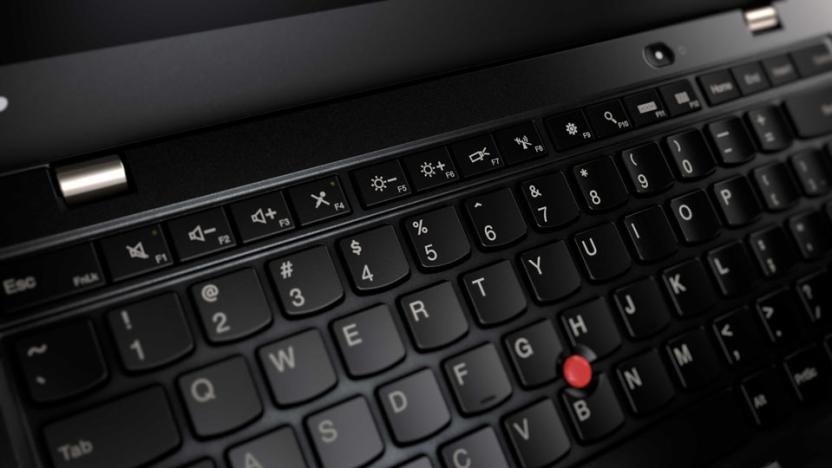
Lenovo's latest business Ultrabook does away with last year's unpopular design
You haven't known a fanboy until you've met a ThinkPad fan. The brand's loyal following (many of whom started as IBM users) can be very resistant to change. How resistant? Let's put it this way: Anytime the brand's current owner Lenovo so much as redesigns the touchpad, it does so at its own peril. That being said, Lenovo may have gone too far with last year's X1 Carbon. With the 2014 edition of its flagship business Ultrabook, Lenovo ripped out the physical Function buttons, leaving users with an "adaptive" panel whose touch-sensitive buttons changed depending on the task at hand. We weren't fond of it, and apparently real-world users weren't either: The company just unveiled the 2015 edition, and it brings back the physical function keys you all seemed to miss so much. Additionally, Lenovo undid some of the changes it had made to the touchpad. Whereas the last-gen model had a clickpad with zero buttons, this year's model returns the two right and left clickers that used to sit at the top of the pad -- the ones meant to be used with the signature red pointing stick.
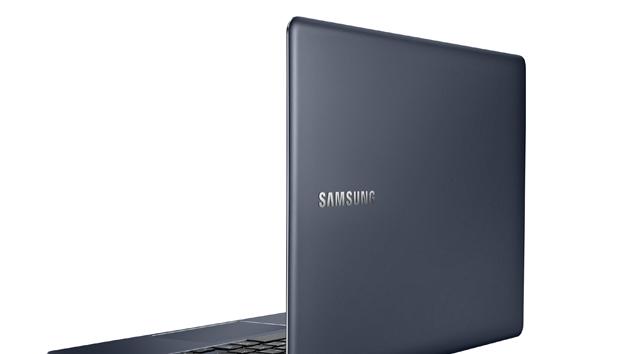
Samsung announces a curved-screen all-in-one and its thinnest laptop yet
We hope you like super skinny laptops, because you're going to be seeing a hell of a lot more of them in 2015. Samsung just took the veil off its new ATIV Book 9 Ultrabook, which comes in at just 0.45 inch thick and 2.09 pounds. That's insanely compact for a 12.2-inch machine and indeed, it's the thinnest and lightest notebook Samsung has released yet. (Given Sammy's history with razor-thin laptops, that's saying a lot.) Like so many other slim machines that have come out lately, the Book 9 uses one of Intel's new Core M processors, which were designed specifically to allow for skinnier designs.
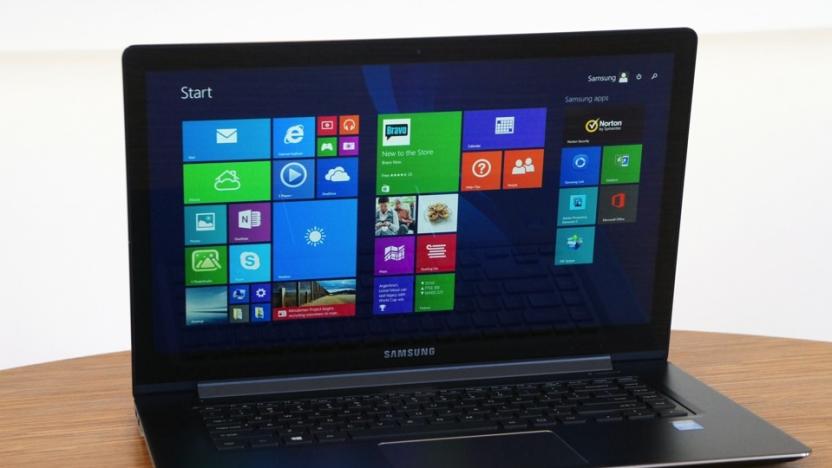
Samsung ATIV Book 9 2014 Edition review: big screen, even bigger price
So many Ultrabooks in our laptop buyer's guide: Not one with a 15-inch screen. Which is strange, because it seemed for a while that bigger-screen ultraportables were going to become a thing; HP, Sony and ASUS all tried their hand at super-light 15-inch machines. Two years later, though, Samsung is one of the only companies that's still at it. The company recently came out with the ATIV Book 9 2014 Edition, an update to the 15-inch Series 9 laptop from 2012. Like the original, it's insanely thin and light for a machine with this screen size, except now, it graduates to a full HD touchscreen, longer battery life and updated processors. Most notable of all, it features an improved audio setup with a built-in digital-to-analog converter allowing you to play back lossless, or "studio-quality" audio formats. The thing is, even for a flagship it's pretty expensive: At $1,500, it has one of the highest starting prices we've seen, and there are plenty of similarly specced machines that cost less. That raises an interesting question, then: Who should buy this?
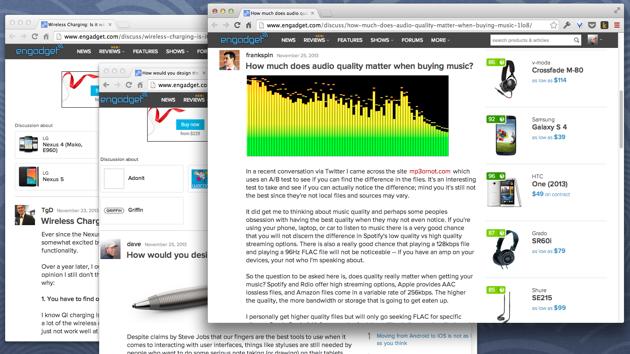
Feedback Loop: Ultrabooks, discrete graphics, Google Voice replacements and more!
Welcome to Feedback Loop, a weekly roundup of the most interesting discussions happening within the Engadget community. There's so much technology to talk about and so little time to enjoy it, but you have a lot of great ideas and opinions that need to be shared! Join us every Saturday as we highlight some of the most interesting discussions that happened during the past week. Happy Saturday! This week, we took a look at Ultrabooks with discrete graphics cards, debated the merits of smartwatches, discussed viable alternatives to Google Voice, talked about how we discover new apps and fondly remembered some of our earliest RSS feeds. Head on past the break and join the conversation in the Engadget forums.
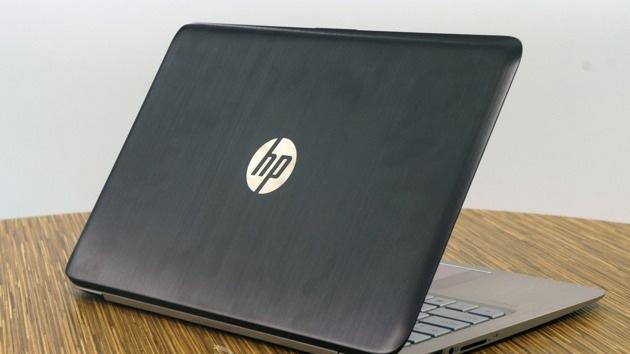
HP Spectre 13 Ultrabook review: a good deal, but with trade-offs
It's already March, dear readers, which means with the exception of this post right here, you're not going to find many laptop reviews on this site. Why? Because Intel's just three months away from launching its next-generation chips and besides, we've reviewed most of the current-gen models anyway. But not HP's. We haven't reviewed a Hewlett-Packard Ultrabook in more than a year. So here we are, picking up where we left off. The company's newest flagship, the Spectre 13, has a metal-clad body, much like the older models we've tested, except it steps up to an optional 2,560 x 1,440 display and an extra-wide touchpad designed to make all those Windows 8 gestures easier to pull off. It also starts at $1,000, making it a good deal cheaper than most of the other models we'll be name-checking throughout the review. So does that make it a good deal?

Acer's WQHD S7 Ultrabook finally hits the US next week
While we found the S7 a "near perfect" machine, one of our gripes was that Acer didn't offer any versions with a 2,560 x 1,440 high-res display in the US. Now the company is dropping off Wide Quad High-definition (WQHD) S7 laptops in the states, and has already specced out two samples packing a 256GB SSD and 8GB of RAM. The S7-392-6425 will be $1499 and use Intel's i5-4200U processor, while the S7-392-9439 is priced at $1,799.99 with an i7-4500U. You can snag both next week at a variety of online and retail outlets including Frys and Amazon.

Nuance's next-generation Dragon Assistant wants to have a conversation
Remember that partnership Intel and Nuance penned way back when? The fruits of their labor is finally here: Nuance's next-generation Dragon Assistant. The virtual assistant is designed specifically for Intel RealSense technology, and comes with two default personalities: American female or British Butler. The assistant does the normal voice recognition tasks, of course, but Nuance is particularly proud of the program's conversational skills. Asking the virtual Alfred (yes, we prefer British Butlers, it's true) who directed Pulp Fiction, for instance, produces the correct answer: "Quentin Tarantino," but Dragon will also remember you asked that, putting follow up questions (such as, "Hey, who was in that movie?") into the proper context. "This latest version of Dragon Assistant is transformative," Nuance Mobile Vice President Michael Thompson wrote in the company's press release. "People can have an interactive dialogue that is natural and intuitive, with a voice assistant that listens and understand the context of the conversation." Neat. Best of all, the new assistant is available today in devices from Acer, Dell, HP Lenovo and more, in Ultrabooks, notebooks and all-in-one PCs. Asus and Toshiba a will follow early this year, and Lenovo will pack the assistant into a tablet sometime in the next few months. Looking for more details? Check out the company's official announcement at the source link below.

NEC launches VersaPro VX business laptop, VG Ultrabook in Japan
You probably won't ever see these latest NEC computers hit retailers on this side of the Pacific, but if you do your laptop shopping in Japan, it's time to listen up. NEC's just flooded the market with a bounty of fresh models, all likely destined for corporate IT departments, and maybe a few homes. There are a few additions to the Mate series, including an MG all-in-one, along with ML, ME and MB slim towers. Then, on the portables front, there's some VB, VH, VD and VA notebooks, followed by two standouts: a VX laptop for 138,500 JPY ($1,400) and a VG Ultrabook priced at a whopping 261,000 JPY (about $2,650). That first model is available with Intel Core i3 or i5 processors, a WXGA 15.6-inch LCD and integrated graphics. The pricey Ultrabook, for its part, can be had with a Core i5 or i7 processor, four gigs of RAM, a 1,600 x 900-pixel 13.3-inch LCD, integrated graphics and either Windows 8 Pro or Windows 7 (huzzah!). There's plenty more to discover, of course, but we'll leave that up to you. NEC loyalists can get their fix (in Japanese) at the source link below.

Acer intros Aspire R7, a laptop with an adjustable display like an all-in-one (update: video)
When Acer plans a global press event, asking journalists to fly in from twelve time zones away, you know it's going to announce more than just some back-to-school PCs. The company just announced the Aspire R7, a 15-inch laptop whose display sits on a flexible "Ezel" hinge, allowing it to be pushed up and back so that it lies nearly flat -- yep, just like an all-in-one desktop. Similar to the Lenovo IdeaPad Yoga line, too, you can flip the screen all the way back so that it faces away from the keyboard, a feature that seems especially well-suited for giving presentations. In terms of specs, Acer is being a little cagey, but we have learned the R7 has a 15.6-inch, 1080p display with a choice of Core i5 and i7 processors. Pen input is possible too, though you'll be limited to passive capacitive pens (read: there's no active digitizer on board). The whole thing weighs in the neighborhood of five and a half pounds. Also confirmed: it's up for pre-order now for $999, available exclusively at Best Buy in the US. We're told it will ship May 17th. In the meantime, we've got hands-on photos below, and we'll very shortly be adding some first impressions after the break.

ASUS TAICHI 21 review: are two screens better than one?
More Info ASUS reveals TAICHI convertible notebook / tablet with dual 11.6-inch and 13.3-inch displays ASUS TAICHI dual-screen Ultrabook coming in November for $1,300, 13-inch version to follow a month later ASUS TAICHI shipments reportedly pushed to at least December It's tough to forget the ASUS TAICHI: out of all the Windows 8 convertibles we've seen (and we've seen a lot) this is the only one with two screens on board. In particular, it's got one on the inside, which you'd use in regular notebook mode, along with a touchscreen on the outside that allows you to use the PC as a tablet. If you like, you can shut the lid completely and turn the machine into a slate-type of device, but you can also leave the lid open so that you're mirroring your desktop, or displaying something different on each one (imagine the possibilities for presenters!). As an added trick, that outer screen also accepts pen input, though you'll have to splurge on the highest-end configuration to get it with a stylus. For now, ASUS is selling the 11.6-inch TAICHI 21 ($1,299 and up), though a 13-inch version is going to start shipping later this month. Hopefully, though, our review after the break answers questions you'd have about either model. Namely, what's it like to use a machine with two screens, anyway?

Intel makes Touch, Wireless Display mandatory components for Haswell Ultrabooks
We're here live at Intel's CES press conference, where Kirk Skaugen has announced that companies who want to use the Ultrabook name and Haswell internals, it'll have to include touch as standard. The other new condition that Santa Clara is imposing is that the device must carry Wireless Display as standard. On the upside, at least you'll be able to see the images on your TV when your Ultrabook screen gets too greasy from your fingers. Follow all the latest CES 2013 news at our event hub.

Engadget's CES 2013 Preview: Laptops
With CES looming like an electrically charged storm of news and announcements, it's time for us to give you our best bets on what you'll see come January. During the month of December, we'll bring you a series of CES preview posts, forecasting what you can expect when the news deluge begins. For more of what's to come, check out our hub. It's incredible to think that when CES 2012 kicked off back in January we had only reviewed five Ultrabooks. Yep, five. Enough to count on one hand. Even weirder, we still hadn't seen that many by the time we wrapped our coverage of the show. Sure, a few companies teased ultraportables they planned to release later in the year, but these only represented a slice of the 100-plus models slated to launch in 2012. And that didn't even include all the Ultrabook imposters! Ever hear of Sleekbooks? Ultrathins? Whoever said PCs are dead clearly doesn't have to review them for a living.

Mushkin shipping 'world's first' 480GB mSATA SSD in January for $500
Today, component maker Mushkin announced plans to ship the "world's first" 480GB mSATA solid-state drive. Priced at a respectable $500, the made-in-the-USA Atlas SSD is expected to ship beginning in early January, and features a SandForce SF-2281 controller with an unthrottled IOPS, a SATA III (6Gb/s) interface and a three-year warranty. At a little over $1 per gigabyte, ultrabook power users looking to push their storage capacity beyond its current 256GB boundary may want to keep an eye out for this burly option in the coming weeks. For more details, check out the press release after the break.

Acer Aspire S7 review (13-inch): great Ultrabook, a shame about the battery life
Back in June, when Acer first announced the Aspire S7 Series, two things seemed noteworthy: these were the company's first touchscreen Ultrabooks, for one, and they were easily its best-made. Whereas the earlier S3 and S5 skew a bit boring, the S7 is made of aluminum, with either a metal or Gorilla Glass lid, depending on whether you choose the 11- or 13-inch version. What's more, it has a 1080p IPS display, which looked just as nice in our initial hands-on as the spec sheet would have you believe. Throw in a choice of Core i5 and i7 processors and a RAID 0 SSD configuration, and you can easily expect the same fast performance we recorded on the S5. So is this it? Has Acer finally built an Ultrabook we can heartily recommend? More to the point, does the 13-inch model get enough things right to justify that $1,400 starting price? Find out in our review after the break.%Gallery-170640%

Lenovo IdeaPad Yoga 13 review
Make no mistake: Lenovo is taking this Windows 8 thing very seriously. The company's first-generation of Win 8 devices includes everything from a laptop / tablet hybrid to a classic convertible laptop with a swiveling display. Then there's the Yoga. This, too, is a convertible, in the sense that it can be used as a tablet. But it's not like any convertible you used back in the Win 7 era: the screen folds 360 degrees back, turning this Ultrabook into a giant, 13-inch slate. Because of that special hinge, though, you can also bend it into Downward Dog, to use a Yoga term ("tent mode," if you're nasty) or fold the keyboard underneath so that only screen is exposed. It was one of the most memorable things unveiled at CES, and it remains the most striking Windows 8 design we've seen to date. But what's it like to actually use it? And how does it fare as, you know, a plain old $1,000 Ultrabook? Let's find out.%Gallery-170641%

ASUS expands its Zenbook line of Ultrabooks to include 14- and 15-inch models
About a year ago, when Ultrabooks were first starting to go on sale, ASUS was one of the first out of the gate with some lightweight, Intel-approved ultraportables. Since then, it's released a handful of iterations, including redesigned models with improved keyboards and sharper screens. That's a lot for a 12-month period, but there's one area where it fell behind: it tended to ignore larger-screened ultraportables, even as its competitors started selling models with 14- and 15-inch screens. That changed today, as the company announced three new Zenbooks, the 14-inch UX42VS and the 15-inch UX52VS and U500VZ, all of which will go on sale next month. Though the company hasn't issued granular pricing for each possible configuration, we know that prices in the US will range from $699 at the low end all the way up to $2,000. So what do these have to offer, aside from a larger footprint? For starters, the UX42VS weighs 1.9kg (4.19 pounds) and has a chassis that whittles down to 6mm. It makes room for an optical drive, unlike ASUS' smaller Zenbooks, and features NVIDIA GT645M graphics with 1GB of dedicated video memory. Like any other ultaportable worth its salt, it will be offered with Core i3, i5 and i7 processors, though this guys steps up to 6GB of RAM and up to 1TB of hybrid hard drive storage. Moving on, the 15-inch UX525VS (pictured) has a Core i5 or i7 Ultrabook-grade CPU, up to 10GB of memory (!) and up to 1TB in hybrid hard drive storage. The graphics card is the same 645M as on the 14-inch model. As for the U500VZ, it isn't an Ultrabook at all, as it has a standard-voltage, quad-core Core i7 processor. Other specs include 8GB of memory, a 1080p display and a beefier GT650M GPU, this time with 2GB of video memory. Despite the horsepower, though, it weighs in at a relatively light 2kg (4.4 pounds) and measures 6mm thick. Finally, wrapping things up, ASUS still plans to sell touchscreen versions of its 11- and 13-inch Zenbook Prime Ultrabooks. No word on availability for any of these, but we'll follow up with more details as they come in.

ASUS TAICHI dual-screen Ultrabook coming in November for $1,300, 13-inch version to follow a month later
Although we've now seen many dozens of Windows 8 devices, the ASUS TAICHI remains one of the most memorable -- it's unusual, after all, for a PC maker to make a laptop with displays on both sides of the lid. Even when it was announced, ASUS shared some high-level specs, but now we also know how much it'll cost, and when it will be available. As leaked the 11-inch version (aka the TAICHI 21) will go on sale next month, starting at $1,299. A lofty price, to be sure, but no one ever said dual 1080p IPS displays would come cheap. At the entry level, you get a Core i5-3317U processor, 4GB of RAM and a 128GB SSD. For $1,499, it comes with 256GB of storage. Finally, there will be a $1,599 configuration with a 256GB drive and a Core i7 processor. And what of the 13-inch version ASUS showed off earlier this year? An ASUS rep says the TAICHI 31 won't ship until December. Across the board, the TAICHI comes with Intel HD 4000 graphics, two USB 3.0 ports, a 5-megapixel rear camera, a 720p webcam up front, Bluetooth 4.0 and Intel's Wireless Display technology. Again, the smaller, 11-inch version will ship in November with the 13-inch model following a month later. In the meantime, we'll direct you to our hands-on from June if you're hankering for hands-on photos and video.








